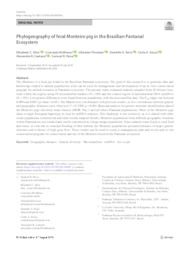Phylogeography of feral Monteiro pig in the Brazilian Pantanal Ecosystem.
Phylogeography of feral Monteiro pig in the Brazilian Pantanal Ecosystem.
Author(s): SILVA, E. C.; MCMANUS, C.; PIOVEZAN, U.; FARIA, D. A.; SOUZA, C. A.; CAETANO, A. R.; PAIVA, S. R.
Summary: The Monteiro is a feral pig found in the Brazilian Pantanal ecosystem. The goal of this research is to generate data and knolewdge related to animal populations wich can be used for management and development of an in vitro conservation program for animal resourses at Pantanal ecosystem. The present study evaluated animals sampled from 10 distinct locations within the region, using 19 microsatellite markers (N=189) and the control region of mitochondrial DNA (mtDNA) (N=392). Low genetic diferences were found between populations with the microsatellite data. The FST range was between 0.009 and 0.063 (p-value<0.05). The Mantel test corroborated with previous results, as low correlations between genetic and geographic distances were observed (r2=0.2309, p=0.06). Bayesian analysis for genetic structure identifcation placed the Monteiro pigs into three main clusters (MOB, Pop 1 and all others Pantanal populations). Most of the Monteiro pigs share a single European haplotype as seen by mtDNA analyses. This haplotype is not exclusive, as it is shared with other swine populations (commercial and other locally adapted breeds). Monteiro populations from diferent geographic locations within Pantanal are not isolated and can be considered as a large unique population. Since animals roam freely to seek food and water, or even due to seasonal fooding of their habitat, the Monteiro populations presented absence of major genetic structure and evidence of high gene fow. These results can be used to create a management plan and in situ and ex situ conservation program for conservation and use of the Monteiro breed in the Pantanal ecosystem.
Publication year: 2020
Types of publication: Journal article
Keywords: Pantanal, Porco, Porco Selvagem, Suinocultura, Suíno
Observation
Some of Embrapa's publications are published as ePub files. To read them, use or download one of the following free software options to your computer or mobile device. Android: Google Play Books; IOS: iBooks; Windows and Linux: Calibre.
Access other publications
Access the Agricultural Research Database (BDPA) to consult Embrapa's full library collection and records.
Visit Embrapa Bookstore to purchase books and other publications sold by Embrapa.

